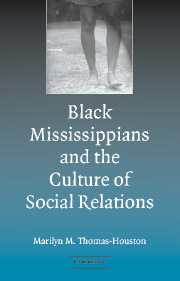Book contents
- Frontmatter
- Contents
- Preface
- Acknowledgments
- Introduction
- PART ONE THE CULTURAL HISTORY AND SOCIAL STRUCTURE OF THE REGION
- PART TWO SOCIAL CONSCIOUSNESS, SOCIAL ACTION
- 3 Social Consciousness and Black Public Culture
- 4 Social Action: A Social Movement in Practice
- PART THREE CONSTRUCTION OF AN INTRARACIAL IDENTITY
- Conclusion
- Appendix A Lafayette County Population Chart
- Appendix B Proclamation Honoring Ole Miss Demonstrators
- Appendix C Chancellor's Statement of Commendation
- Appendix D Speech by Susie Marshall for Second Baptist Church Honoring Rev. Blind Jim Ivy
- Appendix E Susie Marshall's Unpublished Draft of Freedman Town Marker Dedication Speech Recounting July 4, 1867, Speech of Oxford Ex-slave
- Bibliography
- Index
4 - Social Action: A Social Movement in Practice
Published online by Cambridge University Press: 23 December 2009
- Frontmatter
- Contents
- Preface
- Acknowledgments
- Introduction
- PART ONE THE CULTURAL HISTORY AND SOCIAL STRUCTURE OF THE REGION
- PART TWO SOCIAL CONSCIOUSNESS, SOCIAL ACTION
- 3 Social Consciousness and Black Public Culture
- 4 Social Action: A Social Movement in Practice
- PART THREE CONSTRUCTION OF AN INTRARACIAL IDENTITY
- Conclusion
- Appendix A Lafayette County Population Chart
- Appendix B Proclamation Honoring Ole Miss Demonstrators
- Appendix C Chancellor's Statement of Commendation
- Appendix D Speech by Susie Marshall for Second Baptist Church Honoring Rev. Blind Jim Ivy
- Appendix E Susie Marshall's Unpublished Draft of Freedman Town Marker Dedication Speech Recounting July 4, 1867, Speech of Oxford Ex-slave
- Bibliography
- Index
Summary
THE MOVE TO ELECT BLACK CANDIDATES
In the previous chapter, a number of social issues around which a social movement within the African American community could evolve were described. Of those, only two proved strong enough to bring the community together. The two issues, voter registration and the bid to elect a Black sheriff, are so interconnected and interdependent that this chapter describes the two movements as one larger movement. I describe this social action by incorporating three perspectives: the organization spearheading the movement, the candidate, and the wider African American community. The chapter also discusses the failed attempt to rally the community around the block grant controversy.
As mentioned in Chapter 3, soon after my arrival in Oxford, I became aware of two potentially significant actions being undertaken by African Americans – an effort to reestablish the local branch of the NAACP and an attempt by the first African American police investigator in Oxford to be elected Lafayette County sheriff. Plans to achieve these two goals were developed along two very different lines. The young leader of the NAACP believed that the best route to increased membership was to jump right into the middle of any social issue that was currently being addressed by the dominant White society and that had a significant visible impact on the African American segment of that society. By contrast, the police investigator who was running for sheriff was cautious and guardedly tested each political move.
- Type
- Chapter
- Information
- 'Stony the Road' to ChangeBlack Mississippians and the Culture of Social Relations, pp. 99 - 118Publisher: Cambridge University PressPrint publication year: 2004



